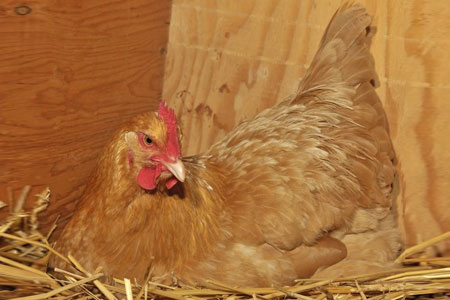
Broodiness is a hen’s instinct to hatch eggs and mother the chicks. A hen that’s thinking of brooding will sit on the nest most of the day and may cluck like a mother hen during the brief time she leaves the nest to eat and eliminate. While she’s on the nest she will puff out her feathers, growl, and peck your hand if you reach under her to retrieve an egg. When a hen goes broody, her pituitary gland releases the hormone prolactin, which causes her to stop laying.
Why Discourage Broodiness
You may wish to discourage broodiness if you keep hens primarily for eggs, especially if you have no rooster and therefore the eggs aren’t even fertile. Or maybe your local zoning regulations don’t allow more chickens than you already have. Or perhaps you keep a rare or valuable breed and you want to hatch as many eggs as possible in an incubator or under other hens.
If your hen is being groomed for exhibition, you would want her to be in peak condition. But a setting hen eats only about one-fifth the amount she normally eats, and some days she won’t eat at all. She therefore could lose as much as 20% of her normal body weight, with too little time to regain condition before upcoming poultry shows.
Discouraging Broodiness
Depending on how serious a hen is about setting, you might discourage her, or “break her up,” using these techniques:
Avoid letting eggs accumulate in the nest. Sometimes the mere sight of a nest full of eggs is enough to trigger broodiness.
Repeatedly remove the hen from her nest. A hen typically prefers to brood where she will experience little disturbance.
Move or cover her chosen nesting site so she can’t get to it. Some hens choose a specific place in which to brood and will be discouraged if they no longer have access. On the other hand, the hen may just move her operation to a new site. In which case…
Move the hen to different housing. The disruption of being moved to a new environment will often discourage a hen from brooding.
Broody Coop
If all else fails, put the hen in a broody coop. Its function is the opposite of what its name implies. It consists of a small, elevated cage that’s light and airy all around, offering no dark corners to hide in. It has a hardware cloth floor and no hay or other material with which the hen might fashion a cozy nest to snuggle into.
A hen is housed in the broody coop for as long as necessary to break her up — usually within one to three days, depending on how long she’s been acting broody. While she’s cooped up, she should get her normal layer ration and plenty of clean drinking water. When she stops clucking and starts being more active, she’s ready to return to the flock. But keep an eye on her, in case she needs a little more time in solitary confinement.
The longer the hen has acted broody, the longer she’ll take to start laying again. A hen that’s broken up after the first day of brooding should begin laying in about seven days. A hen that isn’t broken up until the fourth day may not start laying for about 18 days.
Switch Breeds
Hens, like people, don’t always do what you expect them to, and sometimes a broody hen will persist no matter what you try. If the whole thing seems like too much bother, and all you really want is lots of culinary eggs, consider keeping one of the breeds least likely to go broody.
Your best bet is a commercial white Leghorn strain, or a breed or hybrid derived from white Leghorns, such as the Austra White. Somewhere back in their ancestry, white Leghorns acquired one or more natural mutations that resulted in the loss of parental behavior. In other words, white Leghorn hens have little interest in broodiness, a hallmark trait of the breed that has become a boon to the folks who earn their living selling eggs.
And that’s today’s news from the Cackle Coop.
Gail Damerow is the author of Storey’s Guide to Raising Chickens.

